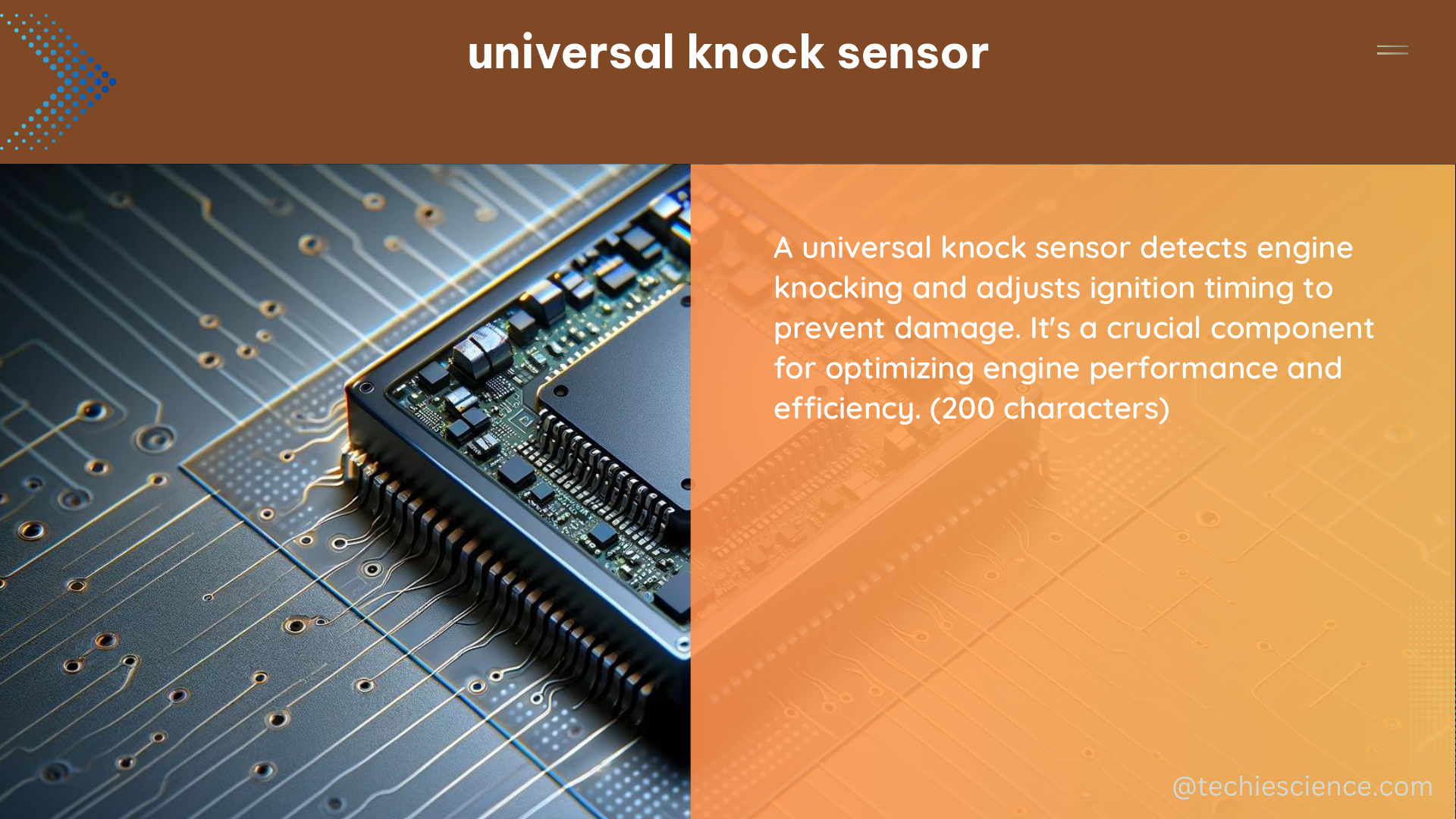Universal knock sensors are essential components in modern internal combustion engines, responsible for detecting and preventing engine knocking or detonation, a phenomenon that can lead to severe engine damage if left unchecked. These sensors work by converting the mechanical energy of engine knocking into an electrical signal, which is then interpreted by the engine control unit (ECU) to adjust the ignition timing and prevent further knocking.
Understanding the Technical Specifications of Universal Knock Sensors
The technical specifications of universal knock sensors can vary depending on the manufacturer and model, but there are several key factors to consider:
Frequency Range
Knock sensors are designed to detect vibrations within a specific frequency range, typically between 5 and 15 kHz. This is the range in which engine knocking typically occurs, so a sensor with a frequency range that encompasses this range will be more effective at detecting and responding to knocking.
| Frequency Range | Typical Range |
|---|---|
| Low-Frequency | 5-10 kHz |
| High-Frequency | 10-15 kHz |
Sensitivity
The sensitivity of a knock sensor is typically measured in millivolts per knock (mV/knock). This value indicates how much the sensor’s output voltage changes in response to a given level of knocking. A higher sensitivity value means that the sensor is more responsive to knocking, but it may also be more susceptible to noise and interference.
| Sensitivity Range | Typical Range |
|---|---|
| Low Sensitivity | 0.1-1.0 mV/knock |
| Medium Sensitivity | 1.0-5.0 mV/knock |
| High Sensitivity | 5.0-10.0 mV/knock |
Mounting Thread Size
The mounting thread size of a knock sensor determines how it can be attached to the engine. Common thread sizes include M12 x 1.25 and M18 x 1.5, which allow the sensor to be easily installed on a wide range of engines.
| Thread Size | Typical Applications |
|---|---|
| M12 x 1.25 | Smaller engines, compact designs |
| M18 x 1.5 | Larger engines, heavy-duty applications |
Amplifier and Filtering
Some universal knock sensors may have a built-in amplifier to increase the strength of the electrical signal, and a filter to remove noise and interference. These features can help improve the sensor’s performance and reliability.
Factors to Consider When Selecting a Universal Knock Sensor

When choosing a universal knock sensor, there are several key factors to consider:
- Frequency Range: Ensure that the sensor’s frequency range matches the knocking frequencies of the engine you’re working with.
- Sensitivity: Select a sensor with a sensitivity range that is appropriate for your engine’s knocking characteristics.
- Mounting Thread Size: Choose a sensor with a thread size that is compatible with your engine’s mounting location.
- Durability and Reliability: Look for a sensor that is designed to withstand the harsh conditions of the engine environment, such as high temperatures and vibrations.
- Manufacturer Reputation: Consider purchasing from a reputable manufacturer with a track record of producing high-quality, reliable products.
Installing and Calibrating a Universal Knock Sensor
When installing a universal knock sensor, it’s important to follow the manufacturer’s instructions carefully to ensure proper operation. This may include:
- Selecting the Correct Mounting Location: The sensor should be installed in a location that is close to the engine’s combustion chambers and where knocking is most likely to occur.
- Ensuring a Good Electrical Connection: The sensor’s wiring must be properly connected to the ECU to ensure that the electrical signal is accurately transmitted.
- Calibrating the Sensor: The sensor may need to be calibrated to the specific engine and ECU in order to ensure accurate knock detection and proper ignition timing adjustments.
Conclusion
Universal knock sensors are essential components in modern internal combustion engines, responsible for detecting and preventing engine knocking or detonation. By understanding the technical specifications of these sensors, including their frequency range, sensitivity, and mounting thread size, as well as the factors to consider when selecting and installing them, you can ensure that your engine is protected from the damaging effects of knocking.
References
- NASIOC Forums – Knock Sensor Information
- Mustang6G Forums – Question about Data Logs and Knock Sensor
- Eng-Tips Forums – Knock Sensor Troubleshooting

The lambdageeks.com Core SME Team is a group of experienced subject matter experts from diverse scientific and technical fields including Physics, Chemistry, Technology,Electronics & Electrical Engineering, Automotive, Mechanical Engineering. Our team collaborates to create high-quality, well-researched articles on a wide range of science and technology topics for the lambdageeks.com website.
All Our Senior SME are having more than 7 Years of experience in the respective fields . They are either Working Industry Professionals or assocaited With different Universities. Refer Our Authors Page to get to know About our Core SMEs.